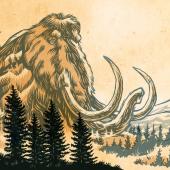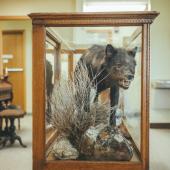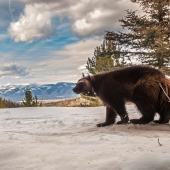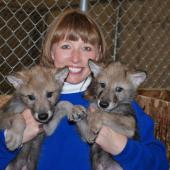Montana in 30 Years: GRIZZLIES
Interview with Louisa Wilcox, Premier Grizzly Advocate
Louisa Willcox has been a wildlife and wilderness advocate in the Northern Rockies for 35 years. She has served as Senior Wildlife Advocate for the Natural Resources Defense Council (10 years), Project Coordinator for the Sierra Club’s Grizzly Bear Ecosystems Project (nine years), and Program Director for the Greater Yellowstone Coalition (10 years).
The year is 2049. What does the Montana grizzly bear population look like?
The prognosis really depends on whether grizzlies are managed by the states or federal government—and that question has not yet been resolved by the courts. If Montana is given management authority over grizzlies, we can expect to see fewer grizzlies outside currently occupied habitat centered on Yellowstone and Glacier National Parks. If the US Fish and Wildlife Service (FWS) continues to manage grizzlies—as has been the case almost continuously for over 40 years under the Endangered Species Act (ESA)—we can expect more grizzlies in more places, including between Glacier, Yellowstone, the Cabinet Yaak—as well as colonizing grizzlies in the vast Selway Bitterroot ecosystem where they have been extirpated.
Montana is blessed with ample suitable habitat to support more grizzlies and to reconnect long-isolated grizzly bear populations, which scientists maintain is essential for long term recovery of species. Whether that happens depends on which agency is in charge, and on who has a controlling voice in management—whether citizens at the local, state, or national levels.
Where in Montana would the bear population shrink, and where might it gain ground?
Grizzlies are showing us with their paws where they can gain ground. Northern Continental Divide grizzlies are moving east outward from the Rocky Mountain Front, south towards the Bitterroot Valley and Sapphires, west to the Cabinet Yaak, and southeast towards Greater Yellowstone. Meanwhile, Yellowstone grizzlies are moving west to the Centennial and Gravelly Mountains, and east along the Beartooth Front. Scientists agree that in the next century, we could see all remaining populations reconnected if current trends continue.
But grizzlies have extremely low reproductive rates, which means that excessive killing could quickly reverse the progress. Grizzlies could lose ground everywhere outside the National Parks with even relatively small increases in rates of death, which are currently driven almost wholly by humans.
In order, what are the three most challenging elements over the next few decades for grizzlies?
Although all elements have the potential to interact in synergistic ways, the three most critical issues include management arrangements, coexistence, and climate change. Starting with management arrangements, prior to when grizzlies were given ESA protections in 1975, the states were contributing to the demise of bear populations by allowing trophy hunts and other excessive killing. Indeed, pioneering grizzly bear researchers John and Frank Craighead feared the imminent extinction of grizzlies in their last few refuges. Thankfully, that did not happen because the federal government stepped in and, through the ESA, imposed a ban on sport hunting, high fines for poaching, and tough rules to keep human foods away from grizzlies.
Under federal oversight, the states and local communities have made a positive difference, especially in fostering coexistence between bears and people. Future challenges center on the adequacy of funding, law enforcement, and the framework for grizzly bear conservation. The best arrangements have proven to be under a national system that gives all citizens a voice in management, but at the same time ensures meaningful roles for state managers and local citizens.
Insofar as coexistence is concerned, because people cause most bear deaths and can be either benign or deadly, the future of grizzlies is literally in our hands. For example, despite record-breaking numbers of tourists in Glacier and Yellowstone National Parks, we see very few conflicts because of effective education and rigorous enforcement of sanitation rules by the Park Service. But even relatively few people can have devastating impacts on grizzlies. The last 45 grizzlies in the remote Cabinet Yaak ecosystem are critically endangered in large part because of unjustifiable killing and poaching. If even one more female grizzly is killed there every other year, the population will likely go extinct. (See yaakvalley.org). Our attitudes and behaviors will have a major impact on whether grizzlies survive or not.
Finally, warming temperatures and massive wildfires are radically changing the abundance and distribution of bear foods, prompting grizzlies to forage nearer people. As a result, climate change will increase the imperative to redouble our efforts to reduce conflicts rather than respond by simply killing more bears. At this point in time, the verdict still out on what our collective response will be.
2018 was a significant year for the number of grizzly mortalities. Do you believe that there is an optimal size for the greater Montana bear population?
Grizzly bear deaths did indeed shatter records in the Northern Continental Divide and Yellowstone ecosystems last year, but death rates have been high for the past 15 years.
There is a scientific consensus that long-term recovery will only be ensured when our isolated or semi-isolated populations are reconnected with each other and to more robust populations farther north in Canada. A “meta-population” of several thousand grizzlies—more than double current numbers—can be achieved, providing a buffer against the impacts of climate change and human development, but only if we allow grizzlies to colonize the ample potential suitable habitat that currently exists.
But ultimately the “optimal” number is not a scientific question, but rather one of worldviews and values. If we don’t care about grizzlies or opt for high-risk approaches, we will have fewer bears. If we value grizzlies for intrinsic reasons and agree we have a moral duty to protect them, then we will not only have more in our midst but will also have figured out how to peacefully coexist with them.
How will the pace of climate change impact grizzlies over the next 30 years. Can bears adapt?
Like us, grizzlies are amazingly adaptable and can eat a wide variety of foods. But warming temperatures, invasive non-native species, and wildfires are changing where nutritious foods are located on the landscape—and as a result, where bears are relative to people and, with that, the rates at which bears die. For example, the fatty seeds of whitebark pine had boosted female reproduction and kept grizzlies in remote high elevation wilderness but starting in the early 2000s, whitebark pine collapsed due to an unprecedented climate-driven outbreak of mountain pine beetles. Grizzlies have responded by foraging more on meat from elk and cows, which has increased bear deaths as a result of run-ins with livestock operators and big game hunters.
Looking to the future, the current consensus is that climate warming will cause the collapse of key berry-producing shrubs, as well as populations of army cutworm moths that rely on nectar from flowers growing in alpine tundra—a habitat that will largely disappear during the next century. These losses will almost certainly exacerbate conflicts with humans.
The question is not whether grizzly bears can adapt, but whether people can. Conflicts over big game can be dramatically reduced if hunters exercise simple precautions such as not leaving freshly killed animals out overnight, keeping clean camps, carrying pepper spray, and hunting with people knowledgeable about grizzlies. Similarly, livestock-related conflicts can be reduced with the help of careful husbandry practices, electric fence around calving areas, and the use of livestock guardian dogs. In the end, our choices will determine whether grizzlies can “adapt” to climate change.
For the foreseeable future can grizzly bear management best succeed on the federal or state level?
The federal government and the states play critical and complementary roles. The National Park Service and the US Forest Service manage most of the remaining grizzly bear habitat on behalf of all Americans. Under the ESA, the US Fish and Wildlife Service provides key oversight and law enforcement capability, while also protecting the broader national public interest.
But the states provide an irreplaceable on-the-ground presence along with skills in coexistence techniques. The contributions of state personnel such as Jamie Jonkel and Tim Manley cannot be overestimated. They know both bears and people—and have the right personalities (as well as a bag of tricks) to transform problematic situations in seemingly magical ways. We need more people like them at the state and local levels. But they cannot effectively operate in a vacuum of resources and constraints, which is what the Fish and Wildlife Service provides through the ESA.
Imagine for us in what ways might new science applications and technology interact with grizzly populations in the time frame we are discussing?
Successful coexistence work in places such as the Blackfoot, Madison, and Big Hole Valleys give us a preview of how technology, combined with community commitment, can improve grizzly bear management. Solar-powered compost systems for livestock carcasses, along with a program of prompt carcass removal has helped dramatically reduce conflicts in the Blackfoot.
You are speaking of advances in the next 30 years, but 30 years ago, I did not anticipate widespread use of bear pepper spray, which has proven to be an incredibly effective deterrent in close encounter situations. What will the next advance be?
If you were totally in charge of grizzly populations, what would you do over the next 30 years?
I would start by engaging new generations in a conversation about why grizzly bears matter. We can talk about how they are barometers for the health of our ecosystems, their economic benefits to communities around Glacier and Yellowstone, or their value to us spiritually and aesthetically, but each generation needs to decide for itself whether or not grizzlies are worth saving. Because of grizzlies’ low reproductive rates, low densities and other inherent vulnerabilities, meaningful recovery entails a serious and ongoing commitment.
Even after 40+ years of ESA protections, we have only perhaps increased the number of grizzlies in the lower-48 states by half-again more than what we had in 1975. And grizzlies still remain at roughly 3% of their former numbers when Europeans first began to settle the West. If future generations don’t pay attention and don’t care, all of our gains could be reversed, and grizzlies could be relegated to literal and figurative zoos.












Leave a Comment Here